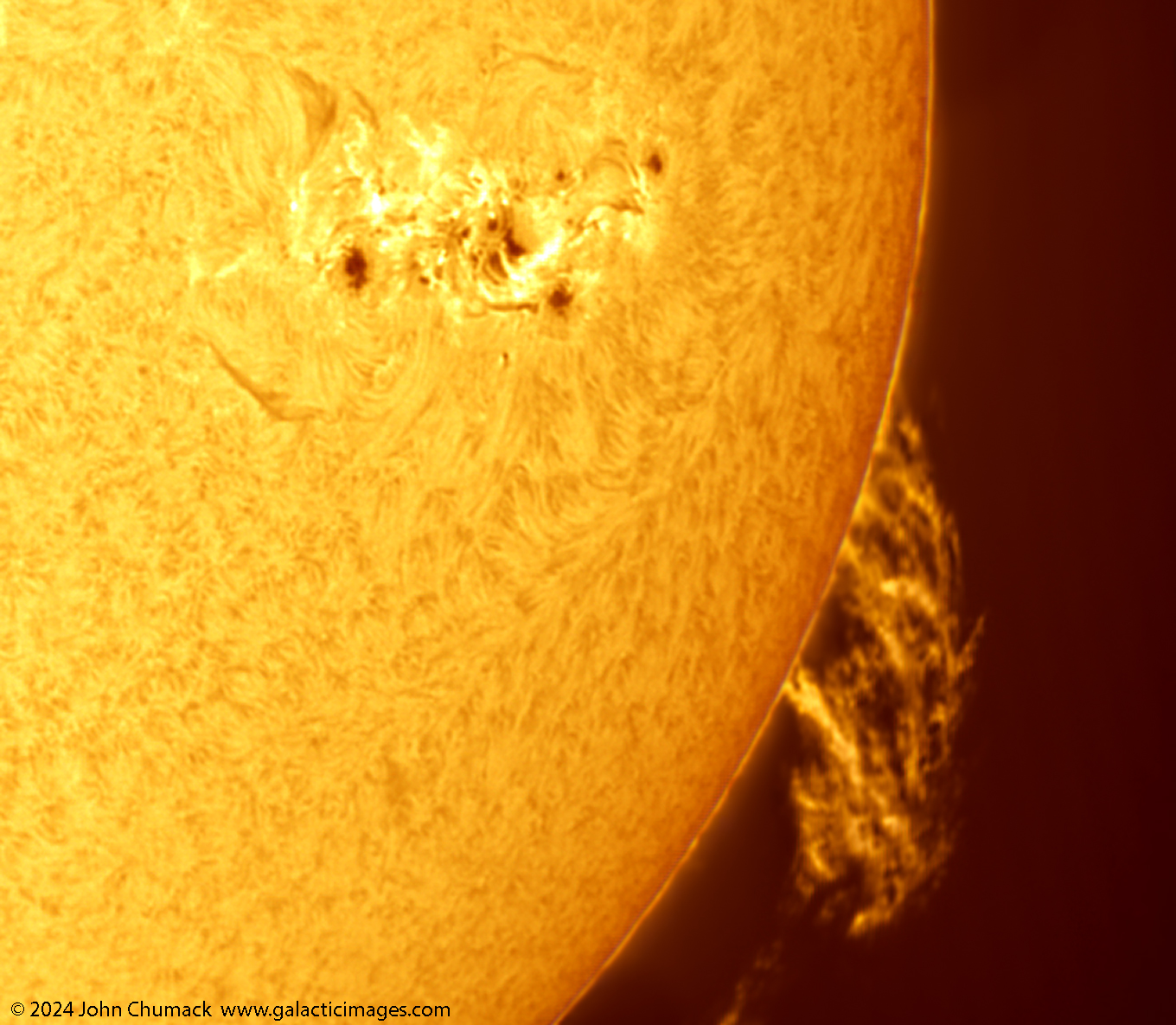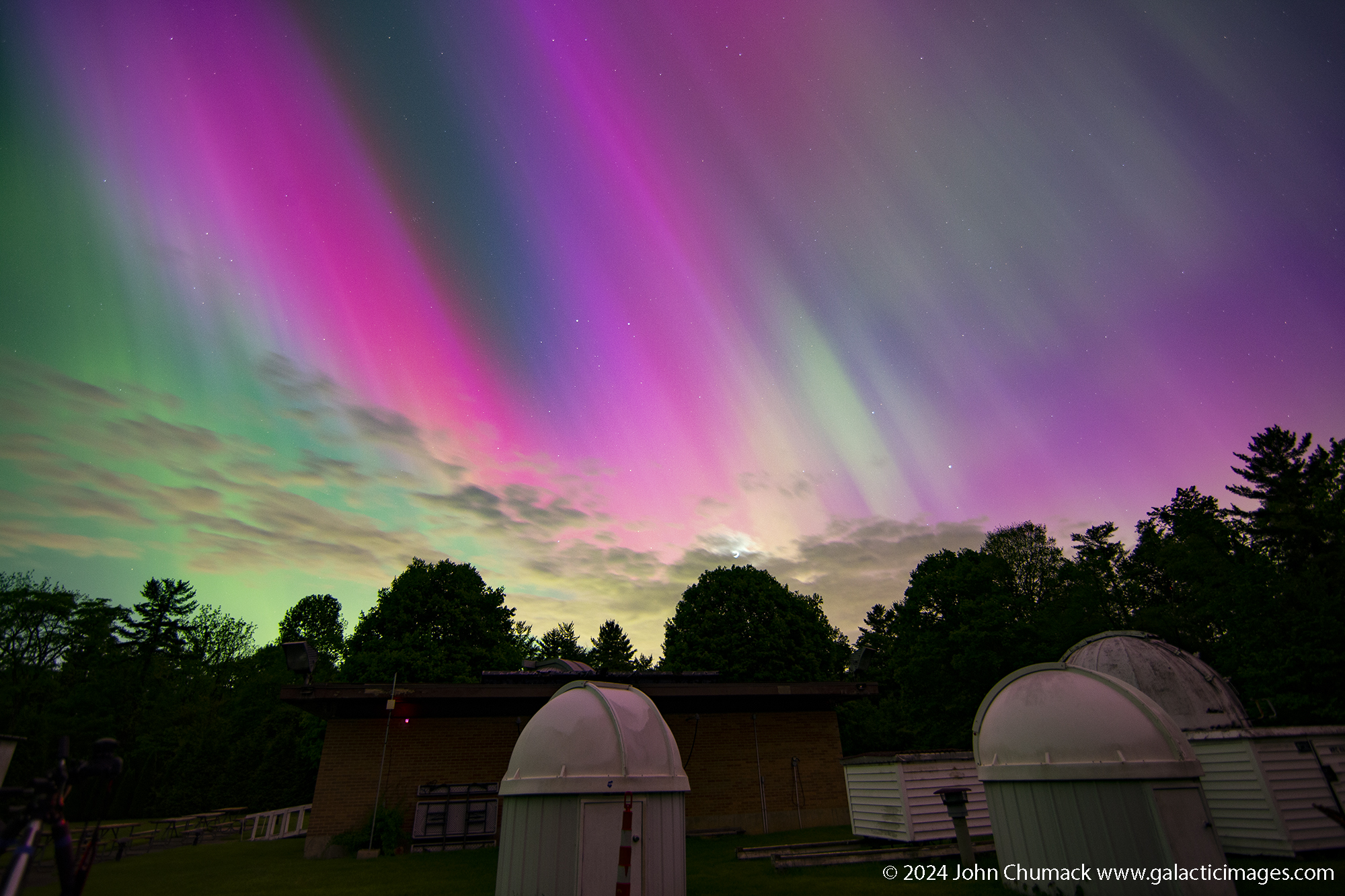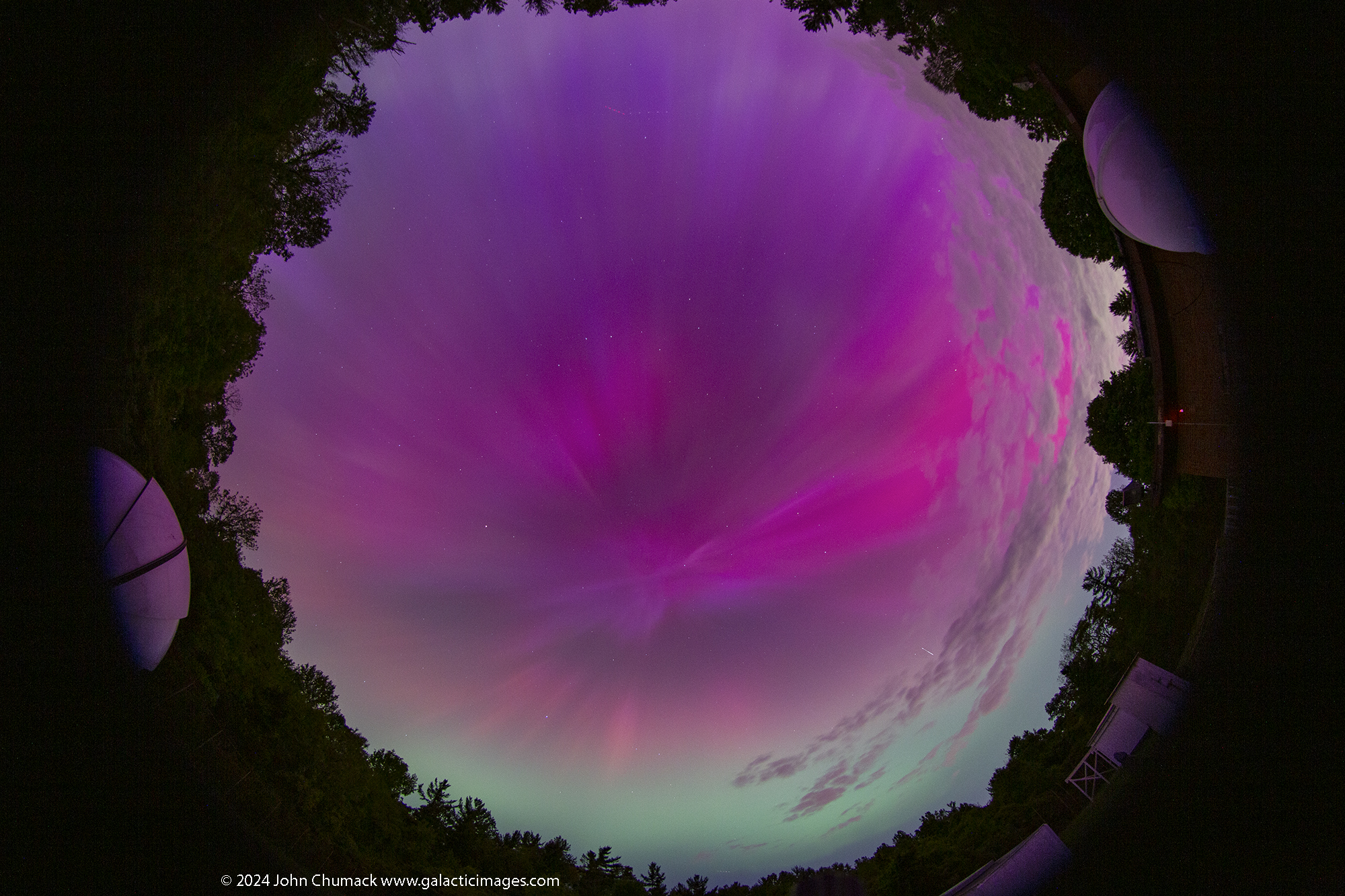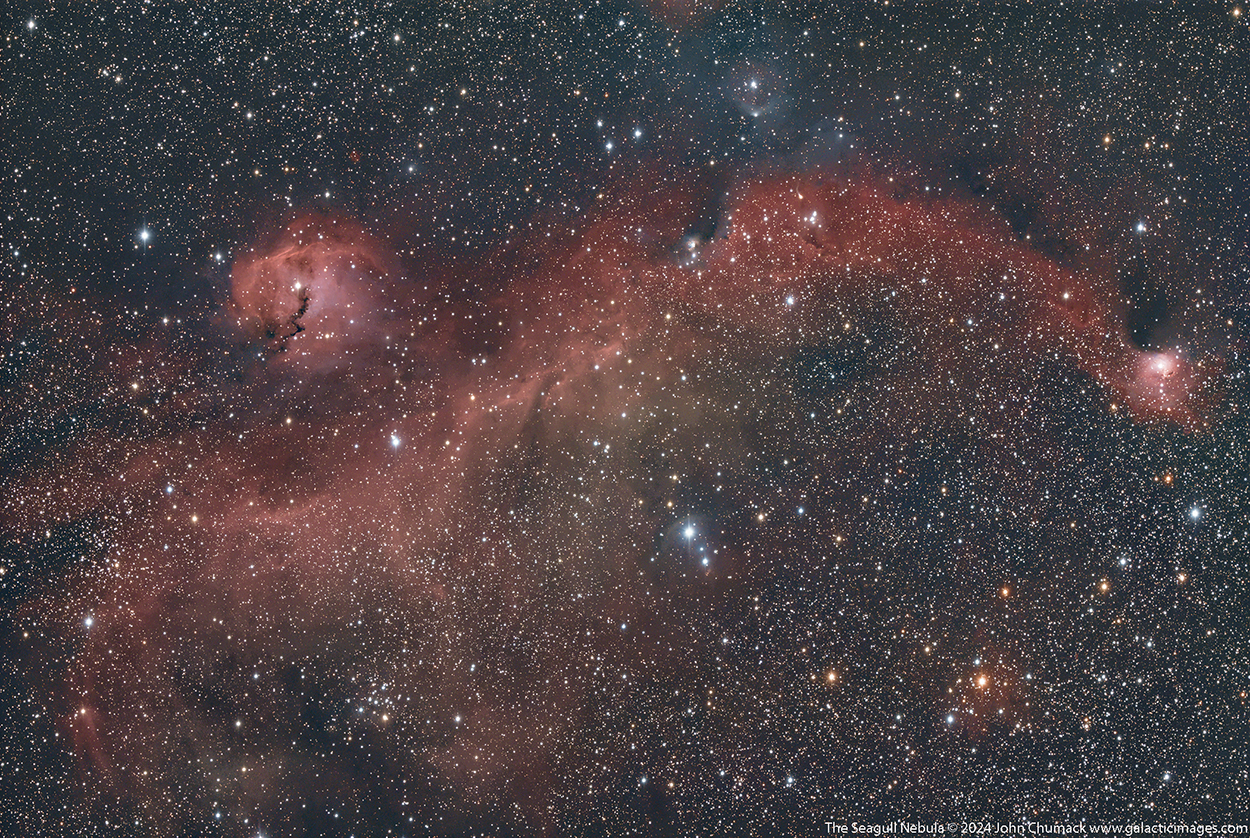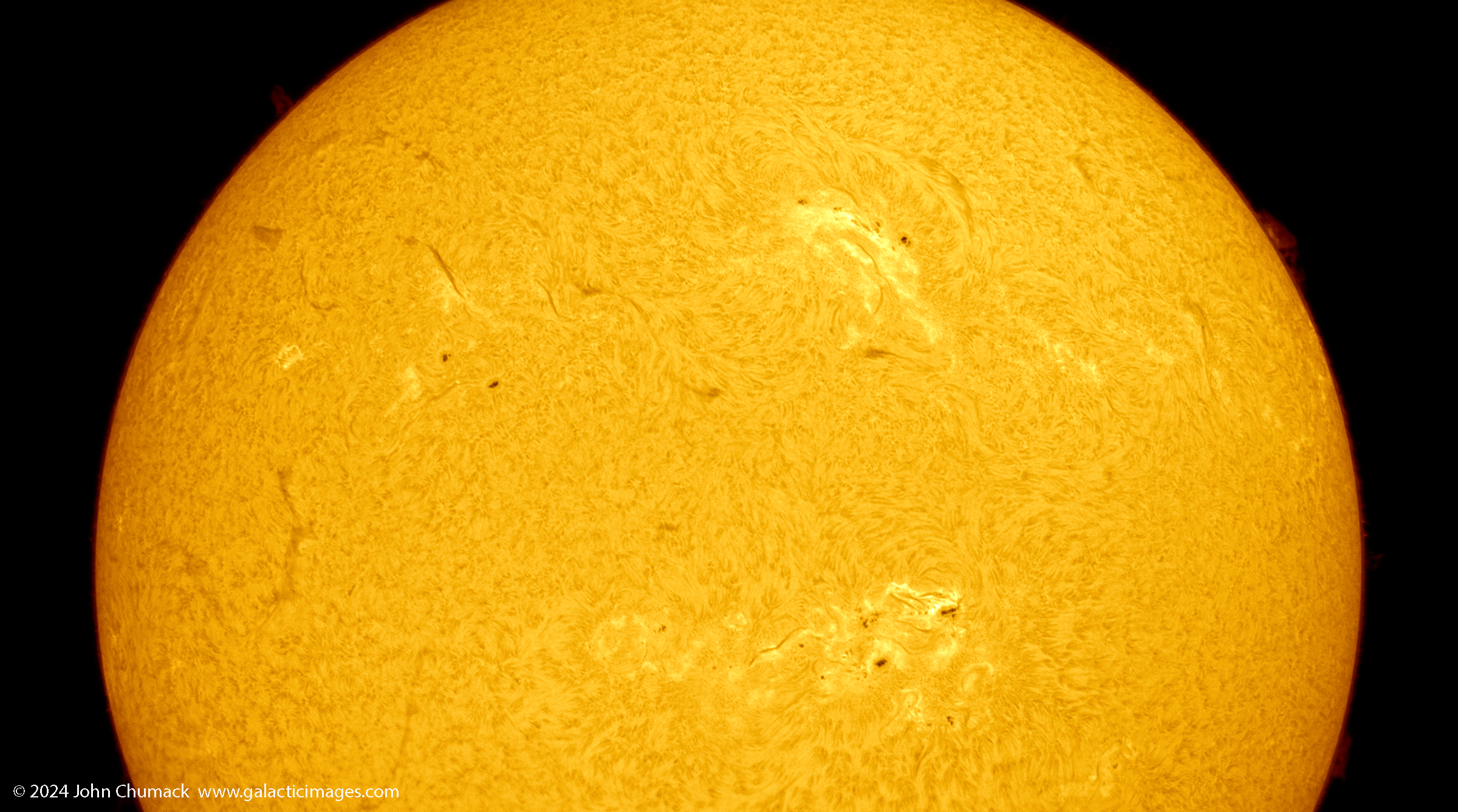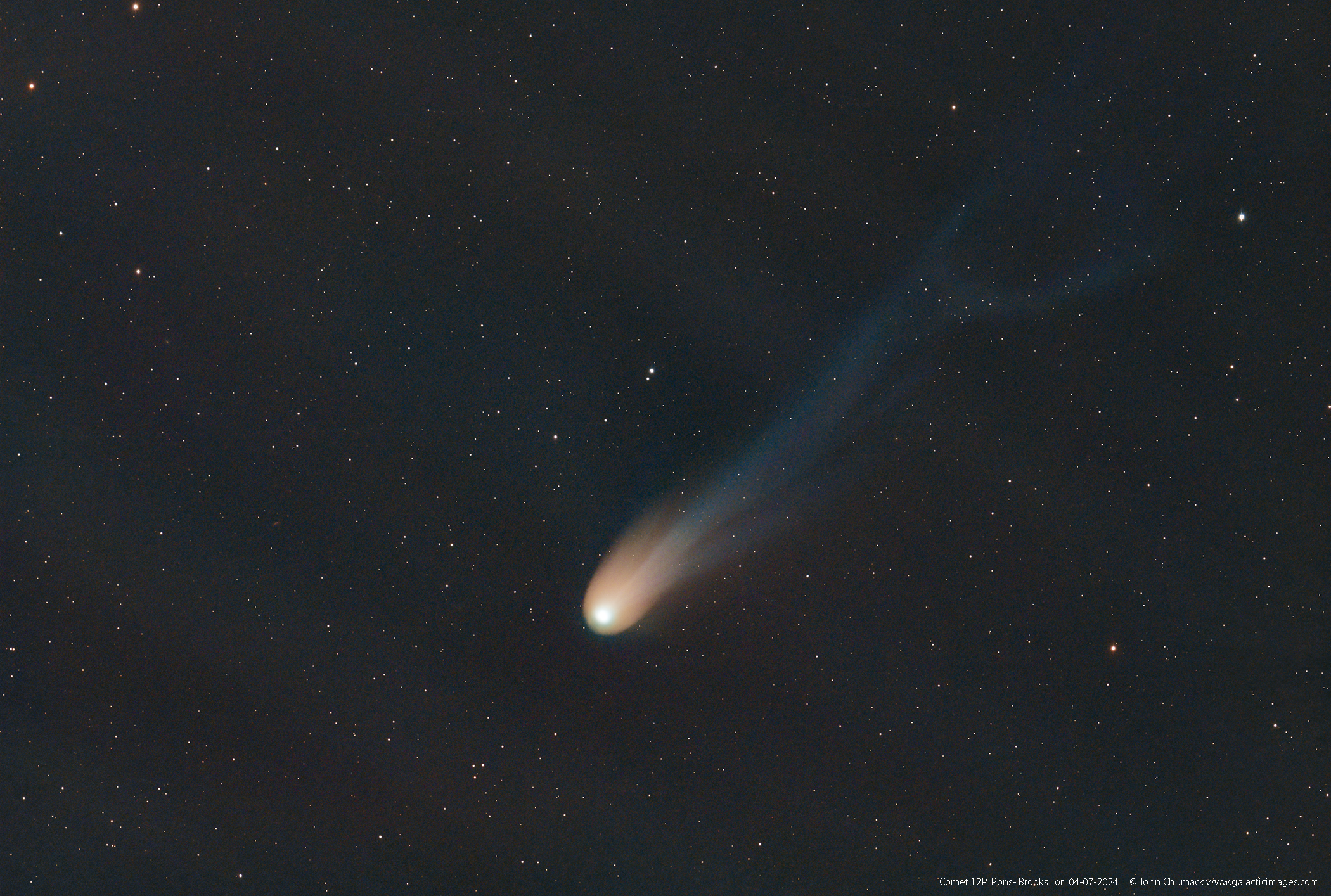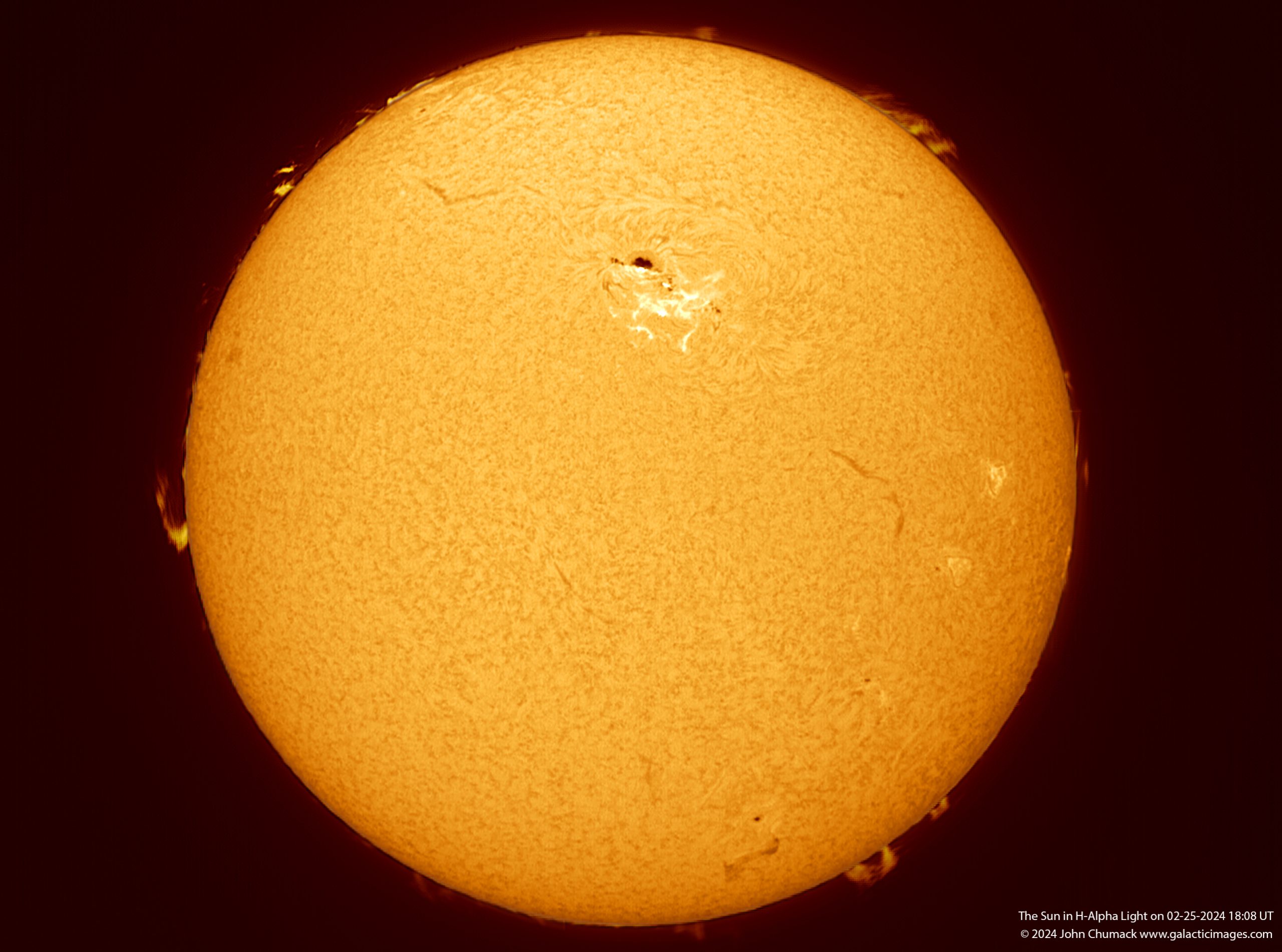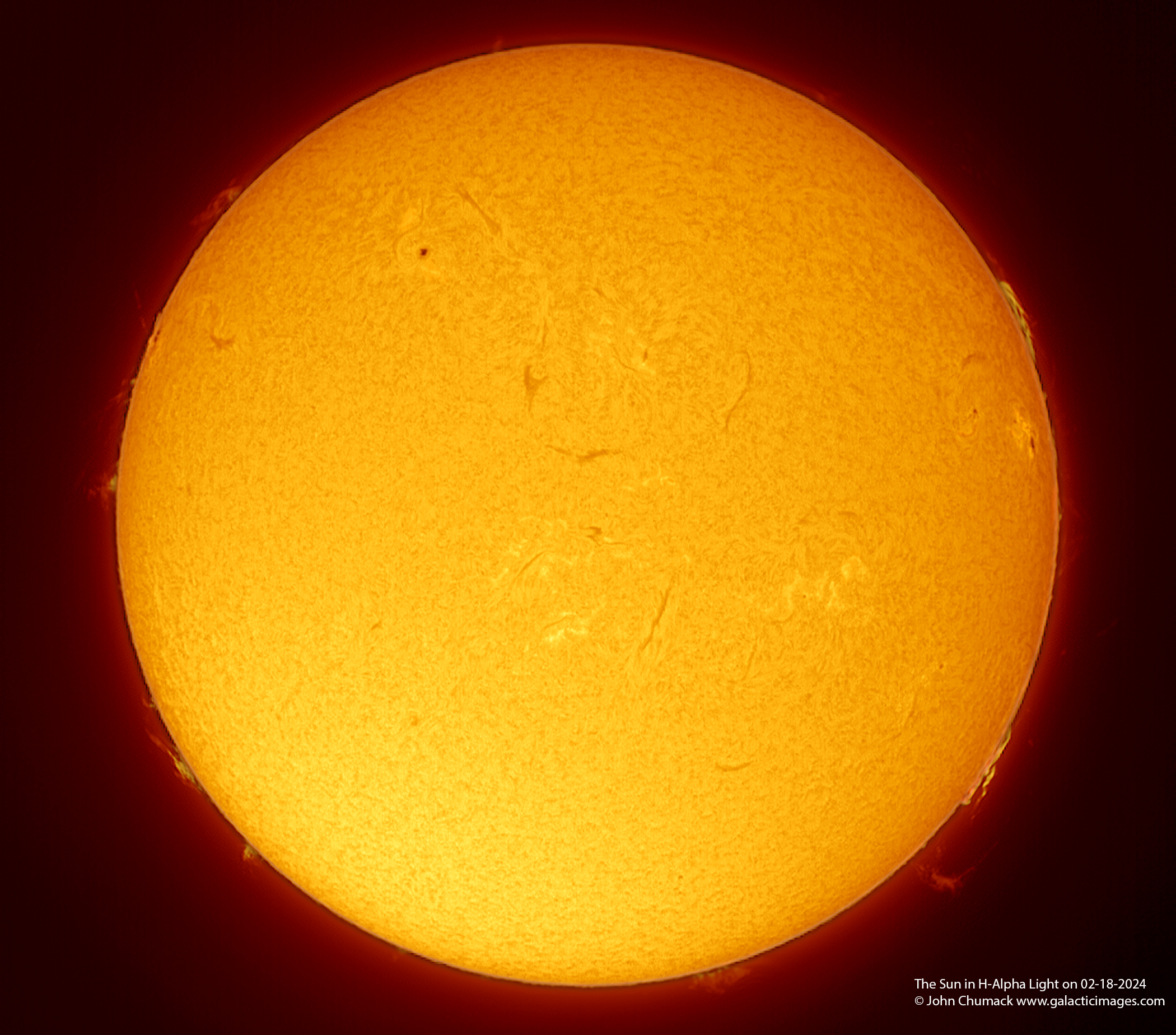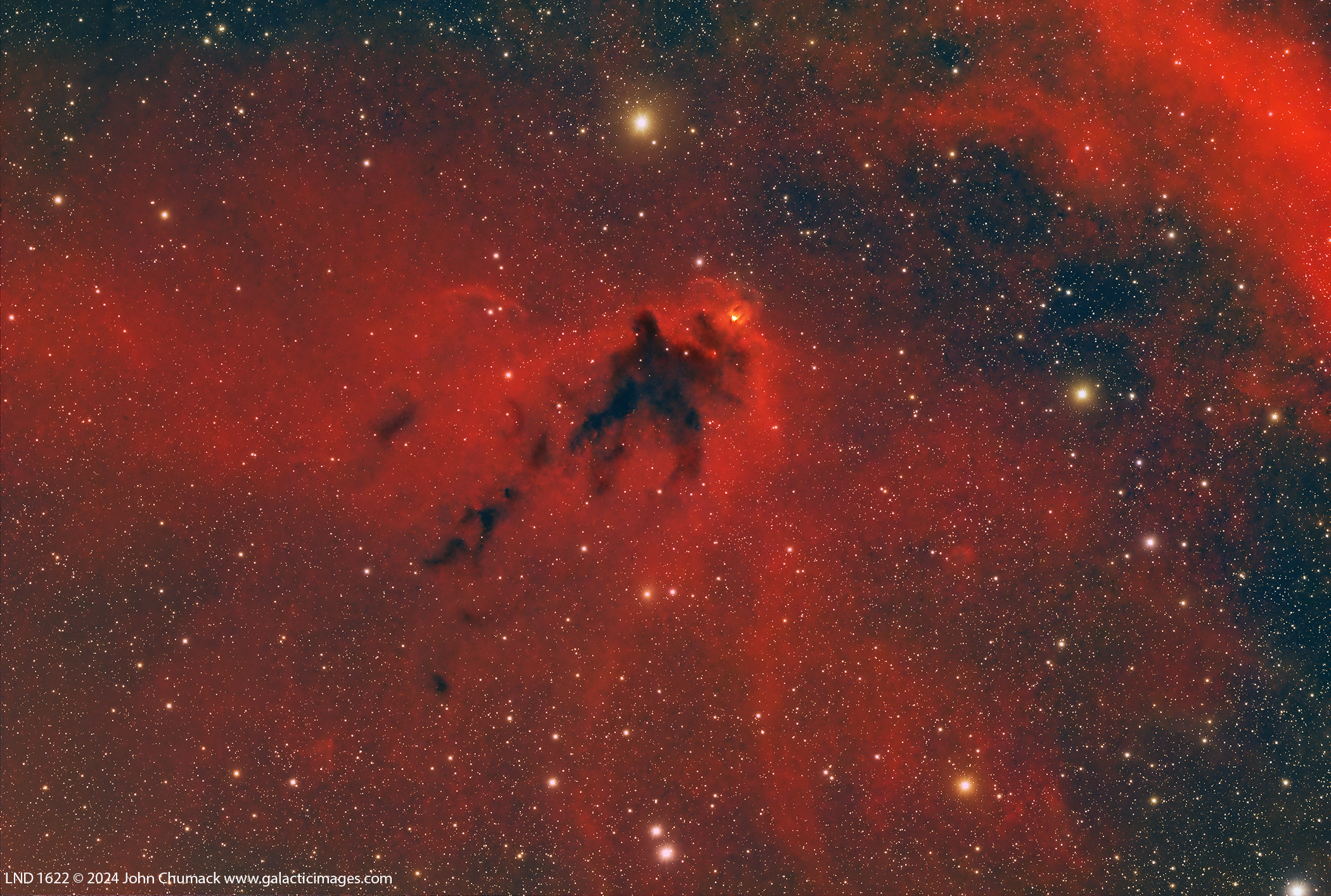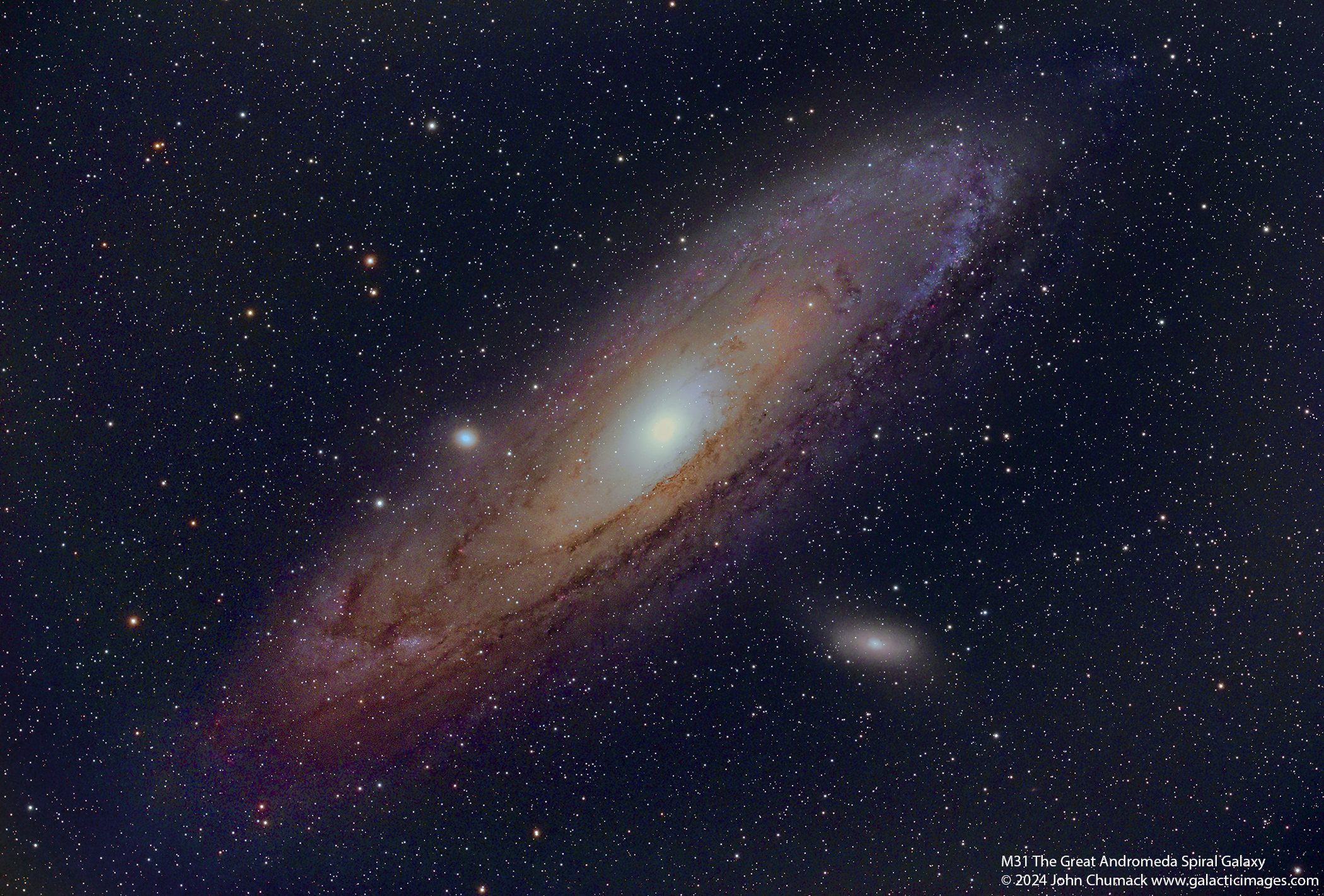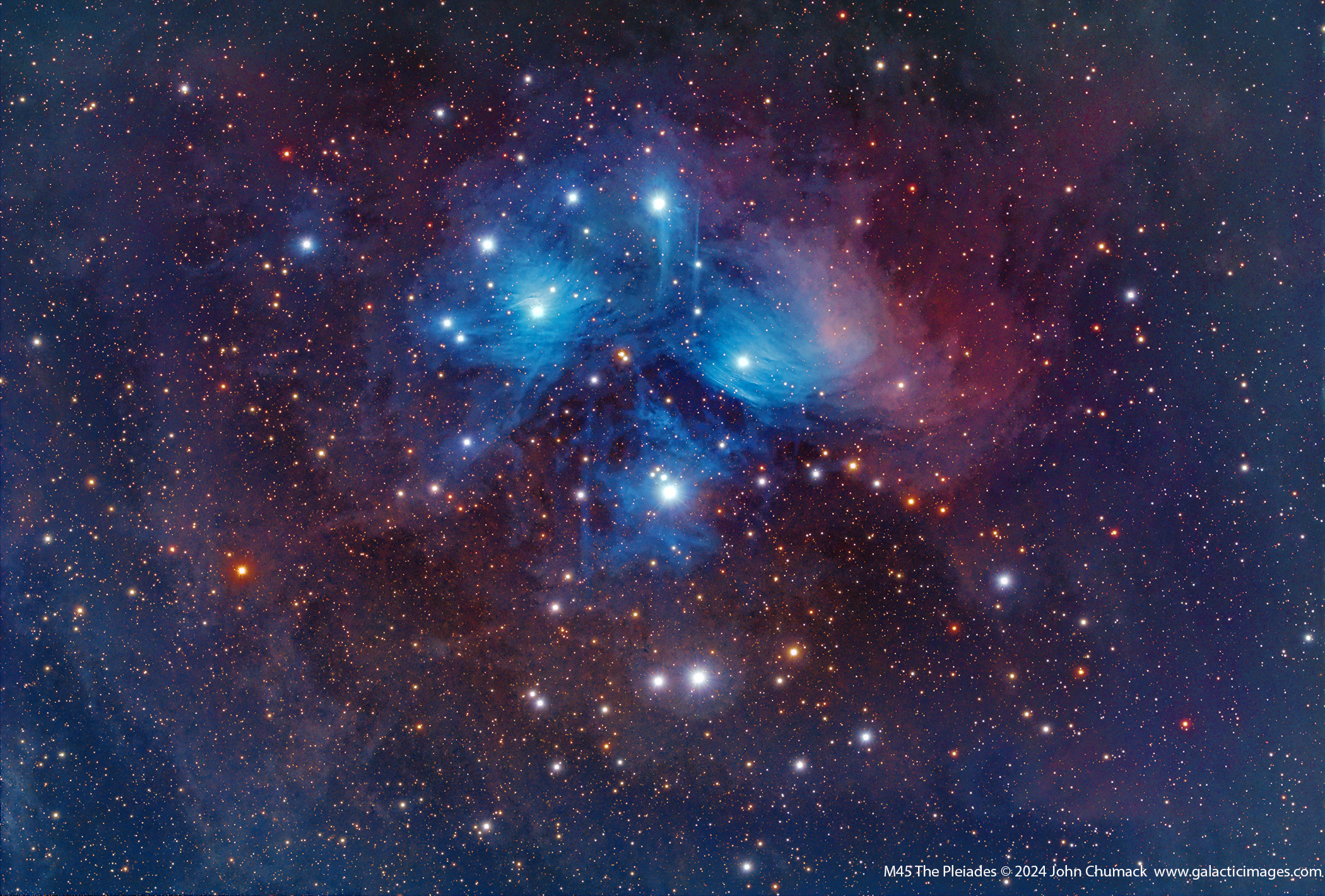Monster Sunspot /Active Region 3664 on 05-10-2024
The Monster Sunspot/Active Region 3664 that gave us that Incredible Aurora display Friday night.
Here is my image of the beast
Sunspot Group / Active Region #3664 and as a bonus a very Large Prominence on the South western Edge of the Sun.
I ran home at lunch time on Friday to image the Sun, since it finally was clear here in Ohio.
The Sunspot group was 15 Earth’s Wide (120,000 miles wide) so you can imagine how big that Prominence on the edge is.
A solar prominence (also known as a filament when viewed against the solar disk)
This Active Sunspot 3664 region had produced at least Six separate X-ray class flares last week,
which created the Geo-Magnetic Storm, Aurora Borealis, aka Northern Lights we all recently got to witness.
Lunt 60mm/50F H-Alpha Solar telescope, Bisque MyT Mount, QHY290M Cmos Camera, 9ms exp., 70fps, Fire-Capture SER Video,
1800 frames stacked in AS4, Registax6, Adobe Raw CC 2024.
Best Regards,
John Chumack
www.galacticimages.com
Amazing Aurora in Ohio Friday night on 10 May 2024
Crazy Good Northern Lights started right at civil twilight, then just kept getting better as it got darker, I shot for several hours, and its still going strong…I also shot the Massive Sunspot & Solar Activity that caused all these light, will share that later this week.
Here are two examples of the hundreds of shots I captured, more to come later.
Captured in front of my observatory Domes at JBSPO in Yellow Springs. 10 May 2024.
It literally covered the entire sky!!!
Best Regards,
John Chumack
www.galacticimages.com
The Seagull Nebula in Monoceros, IC 2177 also known as GUM 1
Here is another shot I captured while down in South Texas last month.
IC 2177 also known as GUM 1, Sh2-292, The Seagull Nebula in Monoceros,
IC 2177 is a region of nebulosity that lies along the border between the constellations Monoceros and Canis Major.
The head of the Seagull is a roughly circular H II region centered on the Be star HD 53367.
The region includes the open clusters NGC 2335 and NGC 2343.
You will find some blue reflection nebula and dark nebulae amongst the strong red Emission Nebula.
This stellar Nursery is located 3,653 light years from Earth.
I captured this image from outside of Uvalde, Texas on 04-07-2024.
Using my RASA 8 F2.2 Scope, AM5 Mount, ZWO 294MC cooled Cmos Camera, Optolong L-Quad Filter, ASI Air Plus, Wi-Fi to IPAD,
(14 x 300 sec. Subs) 80 Minutes total integration time.
Best Regards,
John Chumack
www.galacticimages.com
Solar Activity with Sunspot/Active groups, Filaments on 04-20-2024
Good seeing, a large amount of Sunspots/Active regions and Filaments on the Sun’s Surface today. Captured from my backyard observatory in Dayton on 04-20-2024. Major active Regions 3645 and 15 other active sunspot regions.
Lunt 60mm/50F HA scope, Bisque MyT mount and QHY290 Cmos camera for this close-up. 1.1 ms exposures Fire Capture Software, 500 out of 1033 frames, AS3, Registax6, Adobe Raw CC 2024.
The full Disk shot was captured with the QHY5IIL Cmos Camera, 70ms exposure and 750 frames stacked in AS4, Registax6, Adobe Raw CC 2024.
Best Regards,
John Chumack
www.galacticimages.com
Comet P12 Pons Brooks on 04-07-2024
Here is one of my shots of the Comet 12P Pons-Brooks, captured during my trip to South Texas.
I captured it from outside Uvalde, Texas on 04-07-2024 using my 8 inch F2.2 RASA Telescope, AM5 Mount, and ZWO 294 MC cooled Cmos Camera, Optolong L-Quad Filter,
For an 8 minute total integration time. (16 x 30 second sub exposures), stacked in DSS, processed in Pixinsight and Adobe Raw CC.
It was only 12 degrees off the horizon , very low in the southwest, some very thin cirrus clouds were floating through during Civil/Nautical twilight ,
Difficult to see this low from Ohio, I was happy to still be able to capture it before it set below the horizon that night in Texas.
Also I was bombarded with a lot of satellite traffic during this short imaging session, but was able to remove traces of most of them after stacking.
The comet was shining at Magnitude 4.4, and had recently brighten up from mag 5.4., a very active nucleus is creating some nice tail features.
I noticed that the Comet’s Coma is sporting a nice hood and each night the tail seems to changes shapes, and on this night I see a large disconnection event near the end of the tail, giving a forked or mermaid / fish shaped tail…my previous shot with the Seestar shows in just two days dramatically different tail morphology.
I wish I was still in South Texas, so I could continue to monitor it each night, but I am happy to have captured of it.
Best Regards,
John Chumack
www.galacticimages.com
The Sun in H-Alpha Light on 02-25-2024
The Sun in H-Alpha Light with a massive Sunspot/Active region 3590,
the Sunspot is 7 Earth Diameters long and continues to grow today.
This Active region released 3 X-ray Class flares to date…with more expected from this region.
The Sunspot is easily visible to your eyes, if you use your Safe Solar glasses that you may have bought for the upcoming solar eclipse.
Take a look with those solar glasses all this week if you have clear skies.
Capture details:
Lunt 60mm/50F H-Alpha Solar Telescope, BF-12, Bisque MyT Mount, QHY5IIL Uncooled Cmos Camera, Fire-Capture Software, SER Video File,
700 Frames stacked in AS4, Registax6, Adobe Raw CC 2024.
Captured from my backyard observatory in Dayton, Ohio USA on 02-25-2024 18:08 UT
Best Regards,
John Chumack
www.galacticimages.com
The Sun in H-Alpha Light on 02-18-2024
Finally not a cloud in the sky last Sunday, so I took a peek at the Sun!!!!
The Sun in Hydrogen-Alpha light with Active Sunspots, Prominence’s, and Filaments, basically a ton of fainter Prom activity today!
Sun is active and which means more spectacular Northern Lights for our Annual Aurora Photo Workshop in Alaska in a couple of weeks.
BTW, One spot left for 2024 (due to a last minute Medical Cancellation), any of you want to join us? Contact me ASAP
To see details for the March 12-18, 2024: (1 Space Left)
https://www.galacticimages.com/galactic-tours/alaska-aurora-trip/
We have been teaching this workshop since 2014, this is our 10th year!!
And yes, we always see and capture the amazing Aurora every year.
Capture details:
Lunt 60mm/50F HA Solar Telescope, Bisque MyT Mount, BF12,
QHY5IIL Uncooled Cmos Camera, Fire-Capture Software, SER Video Capture, 15FPS, 700 frames Stacked in Autostakkert4, Registax6, Final in Adobe Raw CS 2024.
Seeing was boiling (bad) today, so it is not as good as I would have liked, but I still managed to pull out some details.
Captured from my backyard observatory in Dayton, Ohio on 02-18-2024 at 17:37 UT (12:37pm LT)
Best Regards,
John Chumack
www.galacticimages.com
The Boogeyman Dark Nebula – LDN 1622
The Boogeyman Dark Nebula – LDN 1622
This dark nebula shape looks like a mythical boogeyman.
Scientifically its known as Lynds’ Dark Nebula (LDN) 1622 appears against a faint background of glowing hydrogen gas only visible in long exposures of the region. It is located about 1500 light years from Earth toward the constellation Orion.
Immediately to the right of the boogeyman’s head is the bright reflection nebula VdB62, and Vdb63 is directly below the dark nebula,
The massive bright yellow/orange Star above the Boogeyman is 56-Orionis, a variable Star and close-double star.
You can also see part of Barnard’s Loop in the upper right corner of the frame in this image.
RASA 8 inch F2.2 Scope, ZWO 294MC Cooled Cmos Camera, AM5 Mount, L-Quad Filter, ASI Air Plus, via WiFi to I-Pad, 7 x 300 sec. subs, 35 minutes total on 02-04-2024. Captured from my observatories at JBSPO in Yellow Springs, Ohio.
Best Regards,
John Chumack
www.galacticimages.com
M31 The Great Andromeda Spiral Galaxy – Optolong L-Quad Filter
M31 The Great Andromeda Spiral Galaxy, and the two little galaxies(M32, M110) are gravitationally bound to M31.
M31 is a Sister Galaxy to our own Milky Way Galaxy, its the closest spiral to us, located at 2.5 million light years away.
In 6 billion years from now, the Andromeda Galaxy will collide with our Milky Way and create a new much more Massive Galaxy (Milkdromeda)!
Visible with the Unaided eye from a dark location, and looks great in binoculars too!
Capture details, another quick test with the L-quad filter.
RASA 8 inch F2.2 Telescope, ZWO AM5 Mount,ZWO 294MC cooled Cmos Camera, Optolong L-Quad 2″ Filter, EAF,
I only managed to get 25 minutes of use-able data due to high cirrus clouds, but it turned out okay for such a short exposure.
5 x 300sec, ASI Air Plus, via Wi-Fi to my I-Pad on 02-04-2024. Processed in DSS, Pixinsight, and Adobe Raw CC 2024.
Best Regards,
John Chumack
www.galacticimages.com
M45 The Pleiades Star Cluster or The Seven Sisters on 02-04-2024
Going Deep into The Seven Sisters Star Cluster in the constellation Taurus.
M45 The Pleiades Star Cluster or The Seven Sisters
Tested out a new OptoLong L-Quad 2″ Filter,
I’m impressed with this filter for capturing those dimmer broadband Blue reflection nebulae,
especially from my brighter city Bortle 7-8 skies.
I picked up some fainter HII and Galactic Cirrus around the outer edges of the FOV as well.
I also captured the 17.8 Mag. background Spiral Galaxy UGC 2838,
it can be seen in my image half way between the top edge of the frame and the bright sister star “Electra”.
RASA 8 inch F2.2 , ZWO 294MC cooled Cmos Camera, Opto-Long L-Quad Filter, ZWO AM5 Harmonic Mount,
12 x 300sec., ASI Air Plus, via Wi-Fi to Ipad, 60 minutes total integration time.
Captured from my Observatories at JBSPO in Yellow Springs, Ohio on 02-04-2024.
Best Regards,
John Chumack
www.galacticimages.com


